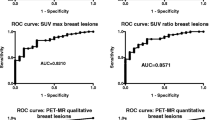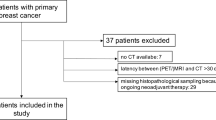Abstract
Magnetic resonance (MR) imaging after ultra-small super paramagnetic iron oxide (USPIO) injection and 18F-fluorodeoxyglucose positron emission tomography (FDG-PET) for preoperative axillary lymph node staging in patients with breast cancer were evaluated using histopathologic findings as the reference standard. USPIO-enhanced MR and FDG-PET were performed in ten patients with breast cancer who were scheduled for surgery and axillary node resection. T2-weighted fast spin echo, T1-weighted three-dimensional (3D) gradient echo, T2*-weighted gradient echo and gadolinium-enhanced T1-weighted 3D gradient echo with spectral fat saturation were evaluated. MR imaging before USPIO infusion was not performed. The results were correlated with FDG-PET (acquired with dedicated PET camera, visual analysis) and histological findings. The histopathologic axillary staging was negative for nodal malignancy in five patients and positive in the remaining five patients. There was one false positive finding for USPIO-enhanced MR and one false negative finding for FDG-PET. A sensitivity (true positive rate) of 100%, specificity (true negative rate) of 80%, positive predictive value of 80%, and negative predictive value of 100% were achieved for USPIO-enhanced MR and of 80%, 100%, 100%, 80% for FDG-PET, respectively. The most useful sequences in the detection of invaded lymph nodes were in the decreasing order: gadolinium-enhanced T1-weighted 3D gradient echo with fat saturation, T2*-weighted 2D gradient echo, T1-weighted 3D gradient echo and T2-weighted 2D spin echo. In our study, USPIO-enhanced T1 gradient echo after gadolinium injection and fat saturation emerged as a very useful sequence in the staging of lymph nodes. The combination of USPIO-enhanced MR and FDG-PET achieved 100% sensitivity, specificity, PPV and NPV. If these results are confirmed, the combination of USPIO MR with FDG-PET has the potential to identify the patient candidates for axillary dissection versus sentinel node lymphadenectomy.






Similar content being viewed by others
References
Morrow M (1996) Role of axillary dissection in breast cancer management. Ann Surg Oncol 3:233–234
Mancuso AA, Maceri D, Rice D, Hanafee W (1981) CT of cervical lymph node cancer. AJR Am J Roentgenol 136:381–385
Som PM (1987) Lymph nodes of the neck. Radiology 165:593–600
Steinkamp HJ, Cornehl M, Hosten N, Pegios W, Vogl T, Felix R (1995) Cervical lymphadenopathy: ratio of long- to short-axis diameter as a predictor of malignancy. Br J Radiol 68:266–270
Luciani A, Dao TH, Lapeyre M, Schwarzinger M, Debaecque C, Lantieri L, Revelon G, Bouanane M, Kobeiter H, Rahmouni A (2004) Simultaneous bilateral breast and high-resolution axillary MRI of patients with breast cancer: preliminary results. AJR Am J Roentgenol 182:1059–1067
Brown G, Richards CJ, Bourne MW, Newcombe RG, Radcliffe AG, Dallimore NS, Williams GT (2003) Morphologic predictors of lymph node status in rectal cancer with use of high-spatial-resolution MR imaging with histopathologic comparison. Radiology 227:371–377
Anzai Y, Blackwell KE, Hirschowitz SL et al (1994) Initial clinical experience with dextran-coated superparamagnetic iron oxide for detection of lymph node metastases in patients with head and neck cancer. Radiology 192:709–715
Bellin MF, Roy C, Kinkel K et al (1998) Lymph node metastases: safety and effectiveness of MR imaging with ultrasmall superparamagnetic iron oxide particles-initial clinical experience. Radiology 207:799–808
Bellin MF, Beigelman C, Precetti-Morel S (2000) Iron oxide-enhanced MR lymphography: initial experience. Eur J Radiol 34:257–264
Anzai Y, McLachlan S, Morris M, Saxton R, Lufkin RB (1994) Dextran-coated superparamagnetic iron oxide, an MR contrast agent for assessing lymph nodes in the head and neck. AJNR Am J Neuroradiol 15:87–94
Anzai Y, Prince MR (1997) Iron oxide-enhanced MR lymphography: the evaluation of cervical lymph node metastases in head and neck cancer. J Magn Reson Imaging 7:75–81
Harisinghani MG, Saini S, Slater GJ, Schnall MD, Rifkin MD (1997) MR imaging of pelvic lymph nodes in primary pelvic carcinoma with ultrasmall superparamagnetic iron oxide (Combidex): preliminary observations. J Magn Reson Imaging 7:161–163
Michel SC, Keller TM, Frohlich JM, Fink D, Caduff R, Seifert B, Marincek B, Kubik-Huch RA (2002) Preoperative breast cancer staging: MR imaging of the axilla with ultrasmall superparamagnetic iron oxide enhancement. Radiology 225:527–536
Stets C, Brandt S, Wallis F, Buchmann J, Gilbert FJ, Heywang-Kobrunner SH (2002) Axillary lymph node metastases: a statistical analysis of various parameters in MRI with USPIO. J Magn Reson Imaging 16:60–68
Koh DM, Brown G, Temple L, Raja A, Toomey P, Bett N, Norman AR, Husband JE (2004) Rectal cancer: mesorectal lymph nodes at MR imaging with USPIO versus histopathologic findings-initial observations. Radiology 231:91–99
Esen G, Gurses B, Yilmaz MH et al (2005) Gray scale and power Doppler US in the preoperative evaluation of axillary metastases in breast cancer patients with no palpable lymph nodes. Eur Radiol 15:1215–1223
Mack MG, Balzer JO, Straub R, Eichler K, Vogl TJ (2002) Superparamagnetic iron oxide-enhanced MR imaging of head and neck lymph nodes. Radiology 222:239–244
Weissleder R, Elizondo G, Wittenberg J, Lee AS, Josephson L, Brady TJ (1990) Ultrasmall superparamagnetic iron oxide: an intravenous contrast agent for assessing lymph nodes with MR imaging. Radiology 175:494–498
Bordat C, Sich M, Rety F et al (2000) Distribution of iron oxide nanoparticles in rat lymph nodes studied using electron energy loss spectroscopy (EELS) and electron spectroscopic imaging (ESI). J Magn Reson Imaging 12:505–509
Lovrics PJ, Chen V, Coates G, Cornacchi SD, Goldsmith CH, Law C, Levine MN, Sanders K, Tandan VR (2004) A prospective evaluation of positron emission tomography scanning, sentinel lymph node biopsy, and standard axillary dissection for axillary staging in patients with early stage breast cancer. Ann Surg Oncol 11:846–853
Byrne AM, Hill AD, Skehan SJ, McDermott EW, O’Higgins NJ (2004) Positron emission tomography in the staging and management of breast cancer. Br J Surg 91:1398–1409. Review
Hoffman HT, Quets J, Toshiaki T et al (2000) Functional magnetic resonance imaging using iron oxide particles in characterizing head and neck adenopathy. Laryngoscope 110:1425–1430
Sigal R, Vogl T, Casselman J et al (2002) Lymph node metastases from head and neck squamous cell carcinoma: MR imaging with ultrasmall superparamagnetic iron oxide particles (Sinerem MR)-results of a phase-III multicenter clinical trial. Eur Radiol 12:1104–1113
Nguyen BC, Stanford W, Thompson BH et al (1999) Multicenter clinical trial of ultrasmall superparamagnetic iron oxide in the evaluation of mediastinal lymph nodes in patients with primary lung carcinoma. J Magn Reson Imaging 10:468–473
Pannu HK, Wang KP, Borman TL, Bluemke DA (2000) MR imaging of mediastinal lymph nodes: evaluation using a superparamagnetic contrast agent. J Magn Reson Imaging 12:899–904
Yamagami T, Yuen S, Sawai K, Nishimura T (2004) MR imaging-guided axillary node biopsy for breast cancer: initial findings. Eur Radiol 14:151–156
Author information
Authors and Affiliations
Corresponding author
Rights and permissions
About this article
Cite this article
Stadnik, T.W., Everaert, H., Makkat, S. et al. Breast imaging. Preoperative breast cancer staging: comparison of USPIO-enhanced MR imaging and 18F-fluorodeoxyglucose (FDC) positron emission tomography (PET) imaging for axillary lymph node staging—initial findings. Eur Radiol 16, 2153–2160 (2006). https://doi.org/10.1007/s00330-006-0276-4
Received:
Revised:
Accepted:
Published:
Issue Date:
DOI: https://doi.org/10.1007/s00330-006-0276-4




